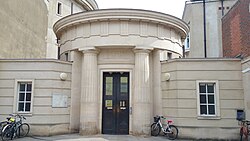Bodleian Art, Archaeology and Ancient World Library
| Sackler Library | |
|---|---|
 The library entrance on St John Street, Oxford | |
 | |
| Location | St John Street, Oxford, England |
| Type | Academic library |
| Established | 2001 |
| Collection | |
| Items collected | The University of Oxford collection specialising in archaeology, art history and classics |
| Size | 300,000 |
| Legal deposit | receives legal deposit books in relevant subject areas via the Bodleian's copyright receipt office |
| Access and use | |
| Access requirements | Current University Card. Bona fide researchers may register to use the Library for reference only. |
| Other information | |
| Employees | 32 |
| Website | http://www.bodleian.ox.ac.uk/sackler/ |
The Sackler Library holds a large portion of the classical, art historical, and archaeological works belonging to the University of Oxford, England.
History
The Sackler Library building was completed in 2001 and opened on 24 September of that year, enabling the rehousing of the library of the Ashmolean Museum. The library entrance is at 1 St John Street. It was principally funded by a donation from the multi-millionaire Mortimer Sackler. It was designed by Robert Adam with Paul Hanvey of ADAM Architecture. Its main building is a circular drum, a reference to the Classical origins of many of its holdings. One of the outer walls of the drum is decorated by a Classical frieze. The architects claim the circular entrance vestibule is derived from the Doric Temple of Apollo at Bassae, first excavated by Charles Robert Cockerell, the architect who designed the adjacent Ashmolean Museum.[1] The Sackler library is administered as part of the multi-site Bodleian Library, the central libraries of the University of Oxford
Controversy
It is a controversial building[2] (like many associated with the university)[3][4][5] as the wealth of the eponymous funders, the Sackler family, was raised in large part from marketing Oxycontin, leading to the US opioid crisis,[6] which has killed hundreds of thousands in the US alone.[7] In 2018, the university said that “[We] would consider any public controversy surrounding a donor [and] may reconsider a donor in the light of new information. At present, there is no intention to reconsider the Sackler family and trusts.”[2]
Collections
Its holdings incorporate the collections of four older libraries, namely the Ashmolean library, the Classics Lending Library, the Eastern Art Library, the Griffith Institute and the History of Art Library. Major subject areas are:
- Western European Art since c. AD 1000
- History of Art
- Classical and Byzantine art and archaeology
- Papyrology and Greco-Roman Egypt
- Near Eastern archaeology and cuneiform languages
- Egyptology and Coptic
- Ancient history
- Epigraphy
- Classical languages and literature
- Prehistoric archaeology of Europe and North Africa
- Archaeology of Roman provinces
- Medieval European archaeology
- Theoretical and scientific archaeology
- Numismatics

Among the celebrated holdings are the Heracles Papyrus, a fragment of 3rd century Greek manuscript containing a poem about the Labours of Heracles, along with over 100,000 fragments found at Oxyrhynchus known as the Oxyrhynchus Papyri.
See also
References
- ^ Robert Adam Archived 2010-07-29 at the Wayback Machine
- ^ a b Cohen, David (20 March 2018). "The Opioid Timebomb: Who are the Sackler family and how does their fortune help bankroll London arts?". Evening Standard. Retrieved 15 July 2022.
- ^ "Oxford University criticised for accepting oligarch's £75m donation" The Guardian
- ^ "Oxford University opens controversial animal research lab". The Guardian. 11 November 2008.
- ^ "Cecil Rhodes statue to remain at Oxford after 'overwhelming support'". The Guardian. 29 January 2016.
- ^ Marshall, Alex (25 March 2019). "Museums Cut Ties with Sacklers as Outrage over Opioid Crisis Grows". The New York Times.
- ^ Research, CNN Editorial (18 September 2017). "Opioid Crisis Fast Facts". CNN. Retrieved 21 September 2020.
{{cite web}}:|first=has generic name (help)

